Over the past several years, technological innovations in the healthcare industry have come and gone, but only a handful of trends have matured and achieved widespread adoption among healthcare organizations, according to experts at TechTarget, who add that bots are another new development that is piquing the interest of healthcare organizations and attempting to become more than a fleeting trend.
Bots are intelligence systems that can interact with end users via text through websites, short message service, and other 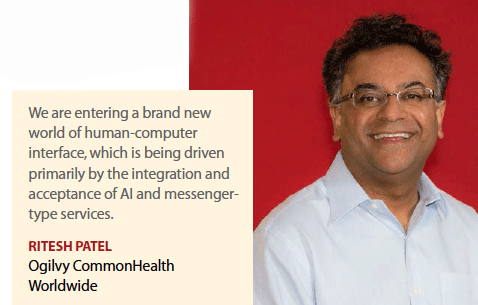 means to provide a service to users. For a health bot to become an established part of healthcare workflows, TechTarget says it must be defined how the health bot can provide value to user organizations. Intelligent bots leverage technologies such as artificial intelligence and natural language processing to offer a more natural interaction between humans and systems. The interest in health bots and chat bots increased significantly this spring, especially after the HIMSS 2016 conference where many platforms were showcased. Bot platforms help to automate processes — particularly real-time messaging — to improve efficiency and outcomes across the spectrum, from physician/patient interactions, to insurance queries, clinical trial processes, and marketing.
means to provide a service to users. For a health bot to become an established part of healthcare workflows, TechTarget says it must be defined how the health bot can provide value to user organizations. Intelligent bots leverage technologies such as artificial intelligence and natural language processing to offer a more natural interaction between humans and systems. The interest in health bots and chat bots increased significantly this spring, especially after the HIMSS 2016 conference where many platforms were showcased. Bot platforms help to automate processes — particularly real-time messaging — to improve efficiency and outcomes across the spectrum, from physician/patient interactions, to insurance queries, clinical trial processes, and marketing.
Several large companies, such as Microsoft and IBM, have introduced “bot as a service" platforms. Supported by the current maturity of artificial intelligence, cloud, and computing power, a health bot can be used to help with many of the current challenges facing healthcare and could be the long-awaited app for connected health, as long as privacy and data security concerns are addressed.
“Health bots are the automated, intelligent applications that make the user of a virtual assistant or text messaging app feel like he or she is talking or texting with an actual person," says Jill DeGraff Thorpe, partner, Manatt, Phelps & Phillips. “But instead of a live person, he or she is communicating with an artificial intelligence platform with big data analytics, natural language processing, and machine learning to personalize its interactions with the user."
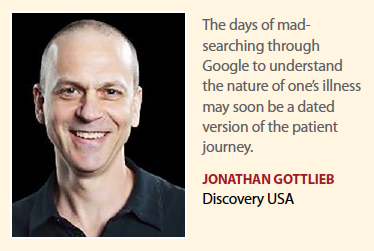 Leading digital platforms, including Google, Facebook, and Apple, launched “bot" developer ecosystems in 2016. Building bots on these platforms offer the advantages of industry leading back-end infrastructure with proven scale, code stability, and network security, as well as the potential to reach billions of consumers. She adds that health bots leverage the native security and virtual assistant capabilities of smart devices, but are otherwise subject to the privacy policies for the bots and underlying platforms.
Leading digital platforms, including Google, Facebook, and Apple, launched “bot" developer ecosystems in 2016. Building bots on these platforms offer the advantages of industry leading back-end infrastructure with proven scale, code stability, and network security, as well as the potential to reach billions of consumers. She adds that health bots leverage the native security and virtual assistant capabilities of smart devices, but are otherwise subject to the privacy policies for the bots and underlying platforms.
Mahesh Naithani, CEO of Medmeme, believes the pharma industry should focus on deploying bots in areas that magnify human intelligence, particularly by allowing industry professionals to perform complex queries on vast databases and quickly receive summarized insights where and when they’re most useful.
“The pharma industry is sitting on oceans of data containing untold value pertinent to every stage in the continuum that stretches from pure research to marketing," he says. “The interfaces to these data sets have evolved from spreadsheets to reports to relational databases to BI analytics. At every paradigm shift, more of the data’s underlying value has emerged. Hands-free interfaces, with head-up displays and voice commands, will empower professionals to access data in a more timely and impactful manner than ever before."
With bots, it will be possible to offer patient engagement and support services such as answering general health questions, presenting interactive labeling information, or helping to connect a patient to a healthcare professional or pharmacy. Health bot technology can act as a virtual companion that checks when medication was taken, record the latest biometric readings, ask about symptoms, or make ingredient substitution suggestions to recipes found on the Internet.
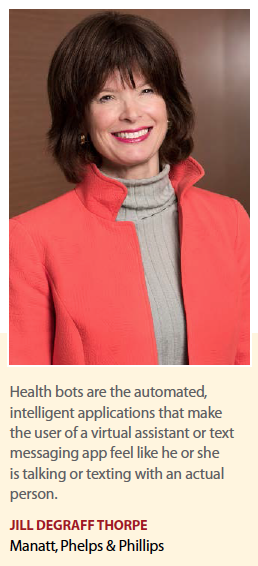 “The development and deployment of health bots is rapidly coming on stream," says Robert Palmer, executive VP, digital innovation officer, Juice Pharma Worldwide. “As patients and providers become more comfortable with automated medicine, and as pharma develops regulatory guardrails that make implementation widespread, health bots will revolutionize patient care."
“The development and deployment of health bots is rapidly coming on stream," says Robert Palmer, executive VP, digital innovation officer, Juice Pharma Worldwide. “As patients and providers become more comfortable with automated medicine, and as pharma develops regulatory guardrails that make implementation widespread, health bots will revolutionize patient care."
Erik Jones, VP, product and data science at Inspire, says the timeline for adoption will be remarkably quick, within the next two to three years, in situations in which AI health bots will be used inside the doctor’s office to answer questions about recommended courses of treatment.
Hatem (Tim) Abou-Sayed, M.D., VP, physician engagement at Interpreta, also believes the timeline for wide adoption of bots is likely within the next three years, as users become increasingly accustomed to context-specific SMS messaging and the options for response, delivery notification, and device security maintenance increase.
While organizations are starting to see how useful bots can be, Anurag Lal, CEO and president of Infinite Convergence Solutions, says there are a lot of requirements that need to be taken into consideration before there is widespread adoption. For example, health bots need to meet the strict standards set forth by the industry specifically with regard to security.
“Many health bots are used within a mobile messaging solution, but unfortunately, many of those platforms and services available today are not HIPAA compliant," he says. “The platform on which a healthcare organization is using a health bot must be built with the correct security measures to keep sensitive health information protected in light of HIPAA regulation."
Additionally, Mr. Lal explains there is an increased importance on monitoring the content shared by health bots due to the type of information being shared. While these health bots can provide a great mechanism of convenience to dissipate knowledge, it’s vital that the information shared is accurate and relevant. Therefore, many organizations may take a cautionary approach in safely deploying health bots because of the accuracy and dependency needed to make sure the information communicated is accurate.
The Future of the Bot
According to the American Telemedicine Association, about 15 million people met with a doctor via an online or telemedicine platform in 2015, a 50% increase from two years earlier.
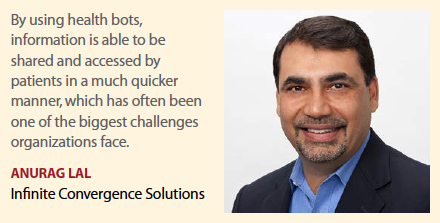 An example of the growth can be seen in HealthTap, a virtual healthcare provider, that has expanded its digital network to more than 100,000 U.S.-licensed doctors, providing virtual healthcare to more than 3,000 cities across all 50 states and in more than 100 cities around the world. The application provides live virtual consults through video, voice, or chat on a subscription basis via smartphone, tablet, or computer. Doctors provide advice, create treatment plans, prescribe, and even review lab tests. HealthTap was the first health bot to use Facebook’s Messenger app to reach millions of users. The site includes up to 310,000 peer-reviewed articles for a range of medical concerns and creates a community between physicians and patients and physician to physician.
An example of the growth can be seen in HealthTap, a virtual healthcare provider, that has expanded its digital network to more than 100,000 U.S.-licensed doctors, providing virtual healthcare to more than 3,000 cities across all 50 states and in more than 100 cities around the world. The application provides live virtual consults through video, voice, or chat on a subscription basis via smartphone, tablet, or computer. Doctors provide advice, create treatment plans, prescribe, and even review lab tests. HealthTap was the first health bot to use Facebook’s Messenger app to reach millions of users. The site includes up to 310,000 peer-reviewed articles for a range of medical concerns and creates a community between physicians and patients and physician to physician.
In an effort to make available its medical knowledge, Boston Children’s Hospital released an app for Amazon’s Alexa voice-powered home appliance. Called KidsMD, the software gives Alexa the new “skill" of offering simple health advice to parents about their children’s’ fever and medication dosing.
Right now, users can download the app on any Alexa-enabled device, including the Amazon Echo, Echo Dot, Amazon Tap, and Amazon Fire TV. Once it’s installed, parents will be able to ask Alexa whether symptoms such as fever, cough, headache, rash, vomiting, sore throat, diarrhea, fatigue, or shortness of breath warrant a call to the doctor. They can also ask about weight- or age-specific dosing guidelines for over-the-counter drugs like acetaminophen.
Health bots represent a huge opportunity for pharma and other healthcare companies. The virtual healthcare market is expected to generate revenue of more than $3.5 billion by 2022, according to a report by Verify Markets. The biggest growth is expected to come from video consultations via laptops, tablets, and smartphones, audio consultations by phone, and kiosks where patients can receive virtual care at various pharmacies and employer sites.
“We are entering a brand new world of human-computer interface, which is being driven primarily by the integration and acceptance of AI and messenger-type services," says Ritesh Patel, executive VP, chief digital officer of Ogilvy CommonHealth Worldwide. “Driven largely by the widespread adoption of technologies, such as Siri, OK Google, and Alexa aka Amazon Echo, these technologies are learning how we speak, what we ask for, and what we use via our mobile devices."
Mr. Patel explains that all this is fueling the development of chat bots — software programs that use messaging, such as SMS/text, as the interface through which to carry out mundane tasks, from scheduling a meeting, to telling us the weather, to helping us book travel and buy tickets, or even to get healthcare assistance.
Chat bots combine the efficiency of people, process, technology, and culture to offer customers a unique digital experience.
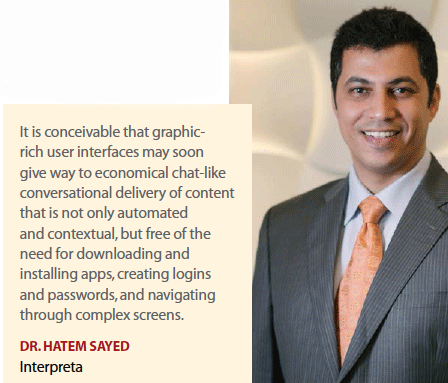 “The evolution of chat bots — from software support to physical products and the app economy — is accelerating as technology becomes more Web-connected and customers rely more on digital for service, support, and sales," he says. “Predominately led by Facebook, WhatsApp, and WeChat, B2C chat bots excel, with thousands of new bots introduced each quarter, while B2B applications are also on the rise.
“The evolution of chat bots — from software support to physical products and the app economy — is accelerating as technology becomes more Web-connected and customers rely more on digital for service, support, and sales," he says. “Predominately led by Facebook, WhatsApp, and WeChat, B2C chat bots excel, with thousands of new bots introduced each quarter, while B2B applications are also on the rise.
“Most notable is WeChat, an app that’s widely used in China, with 570 million users and more than 1 million businesses using the app," Mr. Patel continues. “You can use WeChat to order a meal, book doctor appointments, donate to charity, buy clothes, make payments, and manage money. WeChat connects people to people, but also people to businesses, and it’s become completely mainstream for WeChat users. Facebook has taken on the mantle of providing similar capabilities on its platform with the launch of the Messenger chat bot platform. This will enable millions of Facebook Messenger users simply to use the chat bot to engage with a brand or with others.
Many brands have already created their Facebook Messenger chat bots, from 1-800-Flowers to ABC News in Australia."
With consumers interacting with chat bots in other areas of their lives, this creates a whole new way for the healthcare industry to connect with HCPs and patients.
One of the earliest healthcare chat bots was launched by Baidu in China. This chat bot collects symptom information from the patient using a simple Q&A–type interface, then feeds the data to the doctor before the patient arrives for his or her office visit. Not to be outdone, the UK National Health Service (NHS) has integrated the Your.md chat bot with its NHS Choices database.
“This chat bot allows the patient to interact with a symptom checker bot before visiting the HCP, using credible content from the NHS," Mr. Patel says. “Imagine creating a chat bot for a brand that provides HCPs with up-to-date information, such as the PI, label changes or updates, and simple dosage, safety, and efficacy information. This kind of chat bot could augment the salesforce and allow HCPs to obtain help when they need it 24/7 via their mobile devices. We foresee an explosion of such chat bots for all manner of tasks in the next 18 months, and healthcare will see many benefits for providing credible content via these applications."
Experts expect to see new health bots that fit into all three types of “conversational interfaces," including text, i.e., Facebook Messenger; voice, i.e., Apple Siri, Amazon Alexa; and robotic, i.e., Jibo in 2017. In 2017, as healthcare businesses expand their adoption of health bots the next wave will be focused on active, behavior modifying applications.
Bot Opps
Chris Mycek, chief customer officer, at Cadient, a Cognizant company, believes that broadly speaking, health bots can be thought of as any AI application that is brought to bear on a particular point in the drug development cycle.
“With that definition in mind, all types of health bot applications become apparent, many of which are already in the early stages of incubation and rollout," he says. “Health bots are already being used to help identify likely compounds for testing. As quantum computing dramatically increases the power of AI, researchers will soon be able to model thousands of proteins at once, and then simulate the precise interactions of their test molecules."
On the treatment side of things, AI has already been put to work as physicians now routinely call on applications such as IBM Watson for real-time diagnosis.
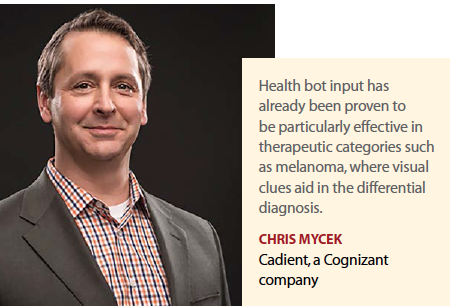 “This type of health bot input has already been proven to be particularly effective in therapeutic categories such as melanoma, where visual clues aid in the differential diagnosis," Mr. Mycek says. “This is also been proven effective in oncology, where there are tremendous amounts of genetic variation and possible treatment permutations that the AI algorithm can sort through."
“This type of health bot input has already been proven to be particularly effective in therapeutic categories such as melanoma, where visual clues aid in the differential diagnosis," Mr. Mycek says. “This is also been proven effective in oncology, where there are tremendous amounts of genetic variation and possible treatment permutations that the AI algorithm can sort through."
Jonathan Gottlieb, director of strategic planning, Discovery, says the days of mad-searching through Google to understand the nature of one’s illness may soon be a dated version of the patient journey.
“Healthcare chat bots — or health bots — have the potential to offer patients and caregivers easier access to complex and sensitive medical subjects by making that process conversational," he says. “Moreover, if these health bots are powered by AI and related technologies, then they have the potential to engage patients in ways that are also personal, responsive, and even empathic. In mental healthcare, AI-equipped health bots are already being used to dialog with patients, monitor indicators such as tone of voice and interaction speed, and signal to care teams when an intervention may be necessary."
Senior care is another promising area for health bots. In forms as varied as humanoid robots and robo-seals with fake fur and eyelashes, health bots are currently providing companionship to the elderly, Mr. Gottlieb explains, adding: Who is likely to be more forgiving of an Alzheimer’s patient’s repeated lapses than a health bot?
Mr. Palmer notes that it has been estimated that more than 40% of nursing care can be handled by “smart" robots that deliver services ranging from dispensing medications to bathing patients in the hospital or home.
Another advantage of health bots is how information can be communicated more quickly and efficiently.
“Health bots can provide a simplistic and convenient mechanism to build up the level of education for patients," Mr. Lal says. “Over time, these health bots can and will become much more intuitive than current iterations and will be able to dissipate knowledge to provide on demand information to patients."
Dr. Sayed believes that it is conceivable that graphic-rich user interfaces may soon give way to economical chat-like conversational delivery of content that is not only automated and contextual, but free of the need for downloading and installing apps, creating logins and passwords, and navigating through complex screens. Instead, a more human-to-human type of interaction mediated by bot software can answer questions, assess risks and compliance issues, deliver instructions, and validate performance in a Q&A-style workflow that fits within already adopted models of social media discourse on our mobile devices.
“Bot technology can disrupt the pharma industry in many ways," he says. “First, market and clinical research among providers and patient groups may be helped by the ability to automate fast pathways for enrollment into clinical trials, with content-on-demand delivery based on a patient’s or provider’s interest in learning more, willingness to participate as a study patient or an investigator, and straightforward identity authentication akin to the way e-commerce sites can now easily authenticate you by your device ID, Facebook login or other already vetted validation step."
Mr. Palmer says the real promise of health bots in the near term lies in chat bots that deliver health-related information in a timely and regulated manner.
“A branded product information chat bot could allow users access to valuable materials quickly, easily, and from any device," he says. “It could explain complex MOAs, play the role of a doctor in an interactive discussion guide, or provide instant access to a co-pay card. Pre-approved algorithms can dispense information while feeding back valuable data on patient questions and needs. Unbranded disease information chat bots can relay complex information while collecting aggregated and blinded patient data. The user can gather all of the information from one place, in a friendly and familiar environment."
Additionally, bots allow a straightforward, asynchronous method for reporting on adverse effects or clinical benefits; rather than pigeonholing the user into fixed menus and picklists, Dr. Sayed says. The bot strategy allows more flexible reporting with a much wider array of metadata that could be incorporated into assessing outcomes of trials. When coupled with sophisticated natural language processing (NLP) technology and artificial intelligence, a bot can conceivably begin to understand how to associate multiple terms (nausea, sick to my stomach, queasy, etc.) into clinically relevant categories, much like how our human brains possess a contextual thesaurus for understanding myriad ways of saying the same thing.
Once trial data are efficiently gathered, the bot process can be used to disseminate the latest results of research rapidly to subscribers, something that list servers have done for decades.
On the commercial side, Dr. Sayed says market research to guide effective forms of marketing and advertising may be aided by bots.
Instead of being inundated with drug ads published in journals, advertised through paid online ads, or distributed through television and streaming media to all readers or visitors of certain sites, a reader can instead tailor subscriptions to only those bots that focus on areas of interest, such as “all drugs for cystic fibrosis," “new studies on pancreatic cancer," or “all meds in Phase III trials from Pfizer," etc.
“Even A/B testing that seeks to identify the most effective advertising imagery and messaging, can be aided by bots, rather than requiring logging into an expert consulting network and navigating through complex matrices of product segmentation and positioning comparisons," he adds. “Once products are on the market, bots can be used to assess drug adherence, particularly when married to IoT smart pill bottles, or even smart pills that more accurately track the exact location and process of metabolism of a drug being consumed.
Reporting back to the payer and clinician, bots can help identify brand-to-generic switching opportunities, pharmacogenomic safety best practices, including opportunities for genomic testing for patients at risk for significant complications of certain drugs with known clinically significant genomic variants, even cost-savings associated with therapeutic interchange. Bot conversations should be relatively easy to incorporate as memorialized documents in the form of structured data when parsed by NLP into EHRs with secure links being issued in turn by the EHR for prescribing changes, adherence surveys, or other outbound deliverables to patients."
Bot Challenges
Mr. Naithani says the greatest challenges with bots are likely to lie in the interfaces connecting to the data — understanding the data, potential analyses, use cases, and user capabilities well enough to generate systems worthy of adoption.
“Bots are reaching ubiquity in daily life — online, in phones, in IoT — but their adoption isn’t universal," he explains. “Hyped products and overly-ambitious promises lead to bad experiences, which in turn lead to category skepticism, under-adoption, and insufficient interaction for improvement. Setting realistic expectations, encouraging frequent communications between developers and users, and providing competent training will facilitate the trust needed to achieve the potential of bots in the pharma space."
Mr. Mycek agrees that acceptance and trust among both the physician and patient communities are two the biggest challenges to adoption.
“Another issue on the horizon for advanced health AI, is the rise of very accurate predicative patient scoring with regard to their likelihood to contract a particular disease, such as Alzheimer’s, cancer, or heart disease," Mr. Mycek continues. “This type of knowledge, while valuable in terms of early intervention and care, will also raise many challenges for patients, families, and the insurance industry."
Health bots come with the same challenges of all digital technologies — privacy and security from hacks must be assured — but quality is perhaps the more immediate challenge, Mr. Gottlieb says.
“The most functional chat bots today work within tight parameters not much advanced from automated call centers," he says. “The worst implode like Microsoft’s Tay, which the Twitterverse was able to corrupt within a matter of hours. The 2016 Gartner hype cycle estimated five to 10 years before conversational user interfaces achieve mainstream adoption. On the other hand, Facebook had some 11,000 chat bots available in Messenger within a few months of introduction. It seems likely that adoption will come sooner rather than later." (PV)
~~~~~~~~~~~~~~~~~~~~~~~~
Bot Insights…
 Karin Beckstrom
Karin Beckstrom
Innovation Lab Senior Product Manager, ERT
The pharmaceutical industry can leverage health bot technology to foster patient participation in clinical trials. Starting with recruitment, health bots will leverage information in electronic medical records to invite targeted patients to participate. This invitation could be launched when a patient indicates interest in clinical trials or where the bot proactively invites patients with matching criteria to learn more about the trial. Additionally, health bots could improve the informed consent process and throughout the trial to ensure all participants receive the same, correct information without losing a personalized, humanized feel. Participants can book appointments at their convenience, ask questions, and be reminded to take medication or of appointments and even be guided when adherence drops off.
 Mark Finn
Mark Finn
VP, Account Director, AbelsonTaylor
As consumers, our expectations relative to the immediate capture of goods and services are increasing. Amazon delivery is becoming faster. Many home services guarantee “same-day delivery." Movies, television, and music are available instantaneously. However, when it comes to making an appointment with a physician, we still often wait days or weeks for an opening. And once in the office, waiting an extra 15 to 20 minutes beyond your scheduled appointment is the norm.
Although these wait times probably haven’t changed much over the last five to 10 years, our expectations have changed.
We want the delivery of all goods and services to increase at the same velocity. And when something like “doctor wait times" don’t keep up, it’s that much more noticeable to us. Enter health bots. Having an intelligent, customizable solution to our healthcare needs better aligns with consumer expectations. Quality, affordable care delivered on demand may drive more regular healthcare utilization without increasing costs, which might ultimately improve overall outcomes. In addition, consumers may be able to navigate all of their clinical and administrative needs with a health bot. Receiving education, a potential diagnosis, treatment options, and aid in navigating the insurance arena may, one day, be available with a single health bot appointment. Health bots may be able to drive much greater efficiency in the delivery of healthcare than any other improvement we’ve seen yet.
 Brendan Gallagher
Brendan Gallagher
Executive VP, Connected Health Innovation, Digitas Health LifeBrands
The challenge pharma will face in creating bots will be finding the right platform. The trick to a successful bot is that it fits seamlessly into the behaviors consumers are already doing. Twitter has had them for years, whether alerting users to earthquakes or recreating lyrics to Billy Joel’s “We Didn’t Start the Fire" using current events. (Seriously, check out @we_didnt_start.) Messenger apps make perfect sense for brand bots because people are already using them to chat with one another. But for pharma to make an impact with bots, companies will have to start partnering. For instance, working with electronic health records for clinical workflow bots to answer drug questions in real time or with pharmacies for automatic inventory management.
 Michelle Keefe
Michelle Keefe
Group President, Publicis Health
Tailored communications to patients all along their journey will be key to brand and therapy success in the future.
Depending on the disease state, a patient’s journey can be complex and multi-faceted. Historically, chronic therapies tend to take a toll on the patient but thanks to digital media, more than 80% of patients and caregivers tend to go to their first HCP visit for their first “second opinion." While digital media has revolutionized the broadcast of treatment options, it is far from modifying the behavior of the patient in terms of influencing outcomes.
There has not been much success in the complex world of patient behavior modification in spite of the digital revolution.
Could the problem be that we as an industry have failed to recognize “response segments" that warrant more customization in the creation, content, and delivery of these messages? Pharma’s work of engaging meaningfully with stakeholders starts at the discovery of the molecule. While pharma has struck gold in recognizing digital as the media, it is still in its formative thoughts at customizing content by segment to resonate and orchestrate the required outcomes.
~~~~~~~~~~~~~~~~~~~~~~
Bot Adoption
 Erik Jones
Erik Jones
Inspire
Mainstream adoption of health bots or chat bots by the patient community will take some time, especially outside of narrow chronic-disease groups. Anecdotal evidence and research have both shown that retaining active users with any system that tracks health is problematic at best, with large majorities of users who stop using Fitbit or MyFitnessPal within six months of starting. Combine this with trust and privacy implications, and the industry has an uphill battle for adoption of these technologies outside of the medical community.
It is very important that the industry focus on a few key points to make adoption among the patient community as widespread as possible, such as:
Place a primary emphasis on privacy of data.
Roll these technologies out in a way that the users have immediate trust in the system.
Do not splinter the technologies to a degree that patients have to use multiple apps to track their health and receive
answers to their questions.
Make asking questions of the health bots, and recording information, as simple and as painless as possible. Minimize user interaction to an extraordinary degree.
Source: Erik Jones VP, Product and Data Science, Inspire


















